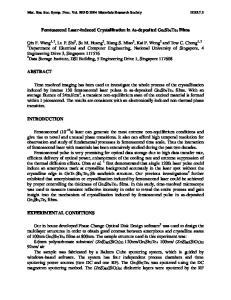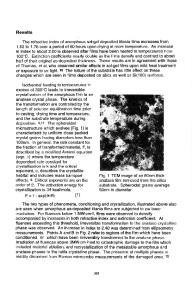Laser Crystallization of Deposited Silicon Films
- PDF / 2,013,713 Bytes
- 8 Pages / 415.8 x 637.2 pts Page_size
- 15 Downloads / 435 Views
Laser ard Electron-Bea•
Inc.
Solid interactions
435
and ".aterials Processing
LASER CRYSTALLIZATION OF DEPOSITED SILICON FILMS G. K. CELLER, H. J. LEAMY, D. E. ASPNES, C. J. DOHERTY, T. T. SHENG, AND L. E. TRIMBLE Bell Laboratories, Murray Hill, New Jersey, 07974, USA ABSTRACT Silicon layers evaporated on crystalline Si have been crystallized by Q-switched Nd:YAG laser irradiation. A strong correlation was observed between the density of a-Si films and the quality of the epitaxial regrowth from the liquid phase. Dense films crystallized epitaxially in a wide range of laser energy densities. Layers with 20% lower density, as determined by spectroscopic ellipsometry, had higher crystallization thresholds and suffered from severe pitting of the surface. Coalescence of the excess void volume into microbubbles, stabilized by gaseous contaminants, is responsible for the surface degradation. In polycrystalline films on amorphous insulating substrates laser melting changes the grain distribution. Rapid melting and solidification of small diameter spots creates concentric rings of large crystallites. This characteristic pattern is explained by a simple model, based on the kinetics of crystallization. INTRODUCTION Recent advances in thin film technology include surface layer modification by transient laser or electron beam irradiation. [1-31 The combination of low temperature film deposition with rapid and localized heat treatment broadens the range of attainable material properties and adds flexibility to semiconductor device design. Laser epitaxy of deposited Si films is an alternative to conventional doping by diffusion or ion implantation, as it is capable of unique impurity profiles. Although high temperature deposition for epitaxial growth is in many aspects comparable to laser epitaxy, it suffers the usual limitations associated with a prolonged exposure of the bulk substrates to high temperatures. Laser epitaxy holds the promise of combining the advantages of low temperature deposition with high quality crystalline growth. Both solid phase [4,5] and liquid phase [61 laser epitaxy have been demonstrated. Solid phase epitaxy (SPE) places very stringent requirements on a vacuum in the deposition chamber (10-9 torr or better) and on substrate surface preparation. On the other hand, liquid phase epitaxy (LPE) can be carried out after film deposition in a vacuum of 10-6
-
10-' torr preceded by a simple
substrate cleaning procedure. Polycrystalline Si films deposited on glassy insulating substrates are commonly used in silicon technology. Recent interest in converting such layers into large grained material which would mimic single crystalline Si led to a widespread use of cw lasers for msec dwell time melting and solidification [7,8]. The nsec pulse melting of such films usually results in submicron grains, [9] except for the recent report where many small
436 overlapping spots were sequentially melted [10]. Concentric rings of large (>lIm) grains were also reported for small diameter individual laser melted spot
Data Loading...




